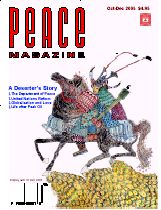
Peace Magazine Oct-Dec 2005, page 31. Some rights reserved.
Search for other articles by PMag staff here
On September 18, voters went to the polls across Afghanistan to elect members of parliament and the provincial council. The electorate is estimated at 12.5 million voters but turnout was about 50 percent -- compared to 70 percent in the presidential election last year. The outcomes may not be clear for two weeks, since many of the ballots are being carried by donkey from remote stations. A minimum of 58 seats were reserved for women, for which more than 300 candidates were competing. Within the 34 provinces, some 5,800 candidates were contesting the 249 seats in the Wolesi Jirga, the "House of the People."
Though the US spent $150 million in organizing the voting, many people doubt that it will really bring about important changes, for two main reasons. First, the candidates include numerous warlords. Though President Karzai was elected after promising to get rid of them, warlords still rule a big part of the country, and Karzai has since not only promised Taliban fighters immunity from prosecution for war crimes, but also defended the warlords' right to run for parliament. He justifies this as "national reconciliation," though some of these people still command private armies. In July, the Electoral Complaints Commission blacklisted 208 such candidates, but only 45 of the lower profile ones were finally disqualified from running.
The second concern about the democratic effectiveness of this election has to do with the election rules themselves. The method is the Single Non-Transferable Vote. Each voter casts a ballot for one individual, rather than selecting a party. Indeed, while political parties are permitted, the party affiliations of the candidates were not printed on the ballots. This scheme is certain to weaken the role of parties in the government and prevent them from exercising discipline over their own elected members. As Joanna Nathan of the International Crisis Group said, "We are not going to see a strong parliament, we are going to see a parliament of 249 individuals."
There are, however, some understandable reasons for Karzai's adoption of this system, at least at this stage. There were over 80 registered political parties, which would keep the party system from functioning properly. Almost all of them amount to only personal followings. In time, they will probably join together to form a small number of true political parties. Besides, the Afghan people are suspicious of political parties because they are associated with communism or with the warlords who had wrecked their country.
Sources: Institute for War & Peace Reporting; Sonali Kolhatkar and Jim Ingalls in Foreign Policy in Focus, Sept. 16 2005.
The Pentagon's Joint Chiefs of Staff have developed a plan (dated 15 March 2005) for the use of nuclear weapons to preempt an attack by a nation or terrorist group using weapons of mass destruction. The plan also envisages use of nuclear weapons to destroy known stockpiles of enemies' WMDs.
So far the draft of this doctrine, "Doctrine for Joint Nuclear Operations," has not been approved by Defense Secretary Donald H. Rumsfeld, but it is expected to be signed within weeks. It would require commanders to request presidential approval before using the bombs.
There are provisions within the doctrine that Congress has not yet accepted. For example, last year Congress declined to fund research on nuclear weaponry to destroy biological or chemical weapons materials without dispersing them into the atmosphere. Nevertheless, the new document calls for nuclear attacks on WMD installations in enemies' deep, hardened bunkers -- the Robust Nuclear Earth Penetrator warheads ("bunker-busters") for which Congress cut funding. Representative Ellen Tauscher (D-California) said the draft was "apparently a follow-through on their nuclear posture review and they seem to bypass the idea that Congress had doubts about the program." She called for hearings on the plan -- behind closed doors, if necessary.
Source: The Sunflower, 20 September 2005.
The Institute for Science and International Security (ISIS) recently estimated that the world has enough explosive material for more than 300,000 nuclear bombs. Two years ago there were 1830 tons of plutonium in 35 countries -- enough for 225,000 bombs. And the amount of plutonium is increasing by 70 tons per year. It is created in nuclear reactors and most of it is in radioactive waste as spent fuel. Some of it has been blended into mixed oxide fuel for power reactors.
Source: Rob Edwards in NewScientist.com; The Sunflower, 20 Sept. 2005.

Peace Magazine Oct-Dec 2005, page 31. Some rights reserved.
Search for other articles by PMag staff here